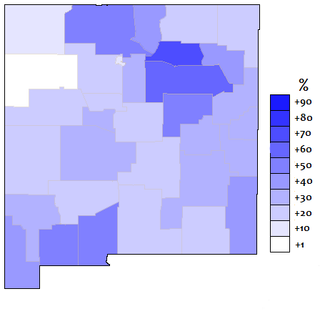
Back New-Mexico-Spanisch German Español neomexicano Spanish Espagnol de Nouveau-Mexique French Castelán neomexicano Galician Espanhol neomexicano Portuguese
| New Mexican Spanish | |
|---|---|
| español neomexicano | |
| Pronunciation | [espaˈɲol neomexiˈkano] |
| Ethnicity | Nuevo Mexicanos |
Early forms | |
| Latin (Spanish alphabet) | |
| Language codes | |
| ISO 639-3 | – |
| Glottolog | newm1235 New Mexican Spanish |
| IETF | es-u-sd-usnm |
 Spanish language distribution in New Mexico by county | |
| Part of a series on |
| Hispanic and Latino Americans |
|---|
New Mexican Spanish (Spanish: español neomexicano) refers to the varieties of Spanish spoken in the United States in New Mexico and southern Colorado. It includes an endangered[1] traditional indigenous dialect spoken generally by Oasisamerican peoples and Hispano—descendants, who live mostly in New Mexico, southern Colorado, in Pueblos, Jicarilla, Mescalero, the Navajo Nation, and in other parts of the former regions of Nuevo Mexico and the New Mexico Territory.[2][page needed][3][4][5][page needed][6]
Due to New Mexico's unique political history and over 400 years of relative geographic isolation, New Mexican Spanish is unique within Hispanic America,[1] with the closest similarities found only in certain rural areas of northern Mexico and Texas;[7] it has been described as unlike any form of Spanish in the world.[8] This dialect is sometimes called Traditional New Mexican Spanish, or the Spanish Dialect of the Upper Rio Grande Region, to distinguish it from the relatively more recent Mexican variety spoken in the south of the state and among more recent Spanish-speaking immigrants.[1]
Among the distinctive features of New Mexican Spanish are the preservation of archaic forms and vocabulary from colonial-era Spanish (such as haiga instead of haya or Yo seigo, instead of Yo soy);[9] the borrowing of words from Puebloan languages,[10] in addition to the Nahuatl loanwords brought by some colonists (such as chimayó, or "obsidian flake", from Tewa and cíbolo, or buffalo, from Zuni);[11] independent lexical and morphological innovations;[12] and a large proportion of English loanwords, particularly for technology (such as bos, troca, and telefón).[13]
Despite surviving centuries of political and social change, including campaigns of suppression in the early 20th century, Traditional New Mexican Spanish is, as of the early 2020s, threatened with extinction over the next few decades;[1] causes include rural flight from the isolated communities that preserved it, the growing influence of Mexican Spanish, and intermarriage and interaction between Hispanos and Mexican immigrants.[14][15] The traditional dialect has increasingly mixed with contemporary varieties, resulting in a new dialect sometimes called Renovador.[7] Today, the language can be heard in a popular folk genre called New Mexico music and preserved in the traditions of New Mexican cuisine.
- ^ a b c d Romero, Simon; Rios, Desiree (2023-04-09). "New Mexico Is Losing a Form of Spanish Spoken Nowhere Else on Earth". The New York Times. ISSN 0362-4331. Archived from the original on 2023-04-10. Retrieved 2023-04-10.
- ^ Cobos (2003).
- ^ Sando, J.S. (2008). Pueblo Recollections: The Life of Paa Peh. Clear Light Pub. ISBN 978-1-57416-085-7. Retrieved June 2, 2024.
- ^ Iverson, P. (1994). When Indians Became Cowboys: Native Peoples and Cattle Ranching in the American West. University of Oklahoma Press. ISBN 978-0-8061-2884-9. Retrieved June 2, 2024.
- ^ Espinosa (1909).
- ^ Espinosa, A.M. (1913). Studies in New Mexican Spanish: Morphology. Sekretariat der "Société internationale de dialectologie romane" Edmund Siemers Allee. Retrieved June 3, 2024.
- ^ a b Cobos (2003), "Introduction"
- ^ Romero, Simon; Rios, Desiree (2023-04-09). "New Mexico Is Losing a Form of Spanish Spoken Nowhere Else on Earth". The New York Times. ISSN 0362-4331. Retrieved 2023-04-12.
- ^ Bills & Vigil (2008), pp. 51–74, Ch.5 "Retentions"
- ^ Bills & Vigil (2008), pp. 153–164, Ch.9 "Uneasy Alliances"
- ^ Bills & Vigil (2008), pp. 93–120, Ch.7 "Nahuatlisms"
- ^ Bills & Vigil (2008), pp. 123–151, Ch.8 "El Nuevo México"
- ^ Bills & Vigil (2008), pp. 165–190, Ch.10 "Anglicisms"
- ^ Cite error: The named reference
ChangingFacewas invoked but never defined (see the help page). - ^ Cite error: The named reference
ABQ crossroadswas invoked but never defined (see the help page).